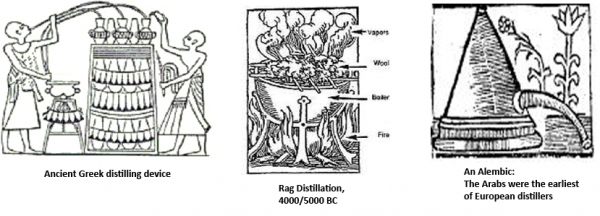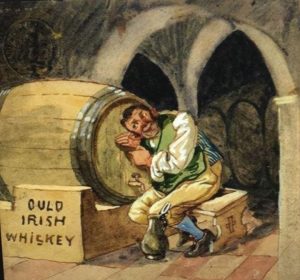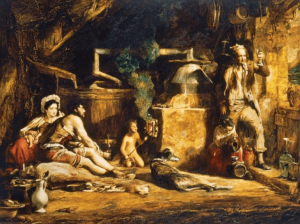From B.C. to the end of the 17th century.
The art of distillation is based on the theory that different substances turn to vapor at varying temperatures and the distilling of spirits has had a long and enduring history. The ancient Greeks believed magical powers were behind the flammable and undrinkable liquids that resulted from early experiments in distillation with ancient Dionysian cults integrating these early spirits into religious rituals. Scholars believe that the earliest recorded wine distilling recipe can be traced back to Anaxilaus of Thessaly, a practicing magus (magician) who was expelled from Rome in 28 B.C. for practicing alchemy which included setting fire to what appeared to be water but ended up being distilled wine.
“There is sea-foam (salt) that has been heated in an earthenware wine-jar with new wine. When this has been boiled, if you apply a burning lamp to it, seizing the fire it sets itself alight, and if poured upon the head it does not burn at all”
Alchemists in Alexandria, Egypt practiced their own form of distilling from around the 2nd century B.C. and had created a few different still types by the 1st century A.D. Their goal was not to distil spirits, but to attain substances such as mercury, arsenic and sulphur to convert the external composition of base metals for the purpose of colouring them gold.
The art of distilling was again proven by the ancient Greek sailors who evaporated drinkable water from sea-water. This was known to the Greeks for centuries before the sophisticated stills of the Egyptian alchemists. They also discovered that if wine was boiled in an open vessel, the magical alcohol vapor escaped first and that if wine was slowly heated in a container with a small mouth covered by a dish, alcohol would collect as condensed vapor inside the dish. The attachment of a descending tube to the structure promoted the cooling and condensation of the vapor with the tube guiding the newly formed liquid into a receiving capsule. Thus, the word “distil” comes from the Latin word “Destillare” which means to “trickle down in minute drops.”

In the 6th century, the Persians practiced distilling at the medical school in Jundishapur (Khuzestan Province of modern day Iran) where it was used to make herbal medications by dissolving drugs in alcohol solution. In the 9th and 10th century, alchemists in Arabia used large, decorated stills to make herbal compounds such as rosewater and to perform elaborate experiments in conceiving solvents for base metals whilst endeavouring to discover the “elixir of life.”
The technique of distillation was also first explored by the Chinese and Egyptians for the extraction of perfumes and then adapted around the eleventh century by European monks for the distillation of wine to produce its spirit. Once the decadent effects of “the water of life” became known – the practice of distillation swiftly spread. In the more northern climates that were not suited for growing grapes, the technique was modified for distilling fermented grains, mostly barley. A form of whisky was already being distilled in Ireland by the 12th century, and this technique was more than likely introduced to Scotland by Irish monks.
Whichever spelling, the origin of the word “Whisk(e)y” goes back to both Ireland and Scotland. It was translated from the Latin word “aqua vitae” meaning “water of life” and used to describe spirits. So, it’s no coincidence that aqua vitae translates to the Gaelic “uisge beatha” in Scots and “usque baugh” in Irish. If you attempt to pronounce these Gaelic words: “uisge” or “usque” out loud, you’ll find that they sound very much like the word ‘whisky’ and as the centuries past, the word was cut down and modernised to simply “whisk(e)y”

Folklore has it that an Irish giant leaped to Scotland with a barrel of whisky on his back. 😉 As much as we all love a good fantasy story though, the truth reads something like this:
In AD 563, St Columba travelled from Ireland and landed on Iona located near the Scottish island of Islay that already had a long tradition of producing malt whisky and a strong historical association with Ireland through their common language of Gaelic. Therefore, it would not be beyond belief to conclude that a primitive still made its way to Islay from Iona by boat, building the early foundations of a whisky industry that would end up been consumed the world over.

The Irish whiskey still by David Wilkie. Painted circ. 1840
The first recorded reference to whisky was in the Exchequer Rolls of Scotland (royal treasury for revenues) during the 15th century in 1494, which list an order from King James IV for “eight bolls of malt to Friar John Cor of Lindores Abby, with which to make aqua vitae”. Following the disintegration of the monasteries in the 16th century, many monks put their newly learned expertise to work as distillers of “uisge beatha” which was gaining huge traction, been famous for its medicinal qualities and a warming remedy in damp, cold climates. Although the process of distillation was initially performed by monks, farmers were quick to learn the art since it was, after all, their grains that contributed the principle ingredients and they took huge advantage enjoying the product of their labours. Ah to be a farmer back then – constantly addled to the gills in this new-found liquid: it would have made for some amazing stories that are now unfortunately lost in the annals of time. ☹
Whisky distillation had become more mainstream and common place on farms throughout Scotland during the 16th century and then the technique was further refined by the evolution of the familiar pear-shaped pot still and the use of cold stream water to improve the condensation of the spirit. It was also in the 16th century that Scottish Lawmakers first started taking a hard line toward whisky production. In 1505, the Guild of Surgeon Barbers in Edinburgh (medical practitioners) approved a monopoly for the production of aqua vitae only to be used as as medicine, and by the mid-16th century, any infringement of these licensing laws would be prosecuted as whisky had become a popular drink. A tax on spirits was first imposed in 1644 and commercial distillers were operating by the end of the 17th century…………
The Old Barrelhouse
Stay tuned for the History of Whisky Part 2. The 18th – 19th century




Leave a Reply